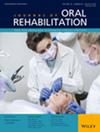Efficacy of Conservative Interventions Targeting Temporomandibular Disorders for Adults With Headache Disorders: A Systematic Review and Meta-Analysis
Abstract
Background
The efficacy of conservative interventions targeting temporomandibular disorders (TMDs) in patients diagnosed with headaches has not been systematically reviewed.
Objective
To appraise the efficacy of conservative interventions targeting TMDs for adults with primary or secondary headaches.
Methods
Bibliographic searches were conducted up to September 2024 for randomised controlled trials in five databases: CINAHL, Cochrane CENTRAL, Embase, PEDro and PubMed. Outcomes collected were frequency, intensity and duration of headache episodes, and disability. Version 2 of the Cochrane Risk-of-Bias Tool and the GRADE approach were used for assessing the methodological quality and grading evidence. Results from trials with similar interventions and with similar outcome measures were pooled into separate meta-analyses.
Results
Five trials were included. Low-certainty evidence suggests that the occlusal stabilisation appliance did not reduce headache frequency (SMD episode/week: −1.57; 95% CI: −2.86 to −0.28; 3 RCTs; n = 145) and intensity (SMD VAS: −0.24 points out of 10; 95% CI: −0.67 to 0.20; 2 RCTs; n = 85) compared to non-specific appliance therapy or no treatment at 1–3 months post-intervention. At 4–9 months post-intervention, low-certainty evidence indicates that the occlusal stabilisation appliance therapy reduced headache frequency (SMD episode/week: 1.21; 95% CI: 0.06 to 2.36; 3 RCTs; n = 145), but not headache intensity (SMD VAS: −0.51 point out of 10; 95% CI: −1.01 to −0.02; 2 RCTs; n = 85). Very low-certainty evidence suggests that overall physiotherapy interventions reduced headache intensity compared to non-specific exercises at 1–3 months post-intervention (SMD NPRS: 4.44 points out of 10; 95% CI: −0.46 to 9.34; 2 RCTs; n = 67) and at 4–9 months post-intervention (SMD NPRS: 3.92 points out of 10; 95% CI: 0.75 to 7.09; 2 RCTs; n = 67).
Conclusion
Our results suggest that clinicians may consider combining orofacial stabilisation appliance therapy and physiotherapy interventions without certainty of their effects for the criteria assessed. The heterogeneity of the interventions assessed and the populations studied means that caution must be exercised when interpreting the results obtained.
Trial Registration
#CRD42023389507

 求助内容:
求助内容: 应助结果提醒方式:
应助结果提醒方式:


